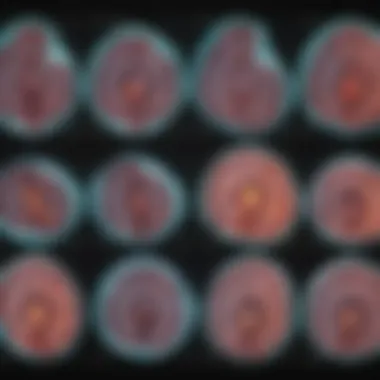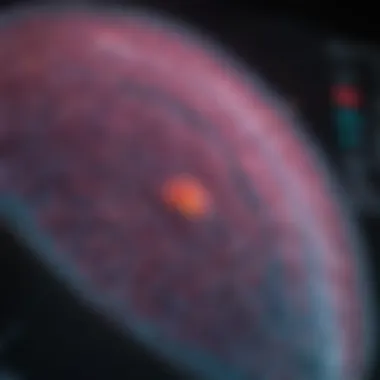CT Scans in Ovarian Cancer Detection: A Comprehensive Analysis


Intro
Ovarian cancer remains a significant health concern, given its often vague symptoms and late-stage diagnosis. Early detection is crucial for improving survival rates and treatment outcomes. As a result, various imaging modalities play an essential part in the diagnostic process. Among these, computed tomography (CT) scans have emerged as a vital tool. This article delves into the role of CT scans in identifying ovarian cancer, examining their effectiveness, advantages, and limitations while also emphasizing the need for a comprehensive screening strategy.
Key Concepts
Definition of Primary Terms
- Ovarian Cancer: A type of cancer that begins in the ovaries, often diagnosed at a later stage due to non-specific symptoms.
- Computed Tomography (CT) Scan: An imaging technique that uses a combination of X-rays and computer technology to create cross-sectional images of the body.
- Diagnostic Process: The series of steps taken to identify a condition, including patient history, imaging, and possible biopsy.
Related Concepts and Theories
Imaging plays a fundamental role in the modern medical landscape. Different imaging techniques—such as ultrasound and MRI—are often compared to CT scans in diagnostic processes. CT scans are particularly known for their rapid acquisition of images, yielding detailed views of the abdominal and pelvic areas, regions where ovarian cancer may be present. Furthermore, the concept of a multidimensional approach in ovarian cancer screening holds relevance here, underscoring that no single tool is sufficient for early and accurate detection.
CT scans can reveal small tumors that may be missed by other imaging techniques, aiding in early diagnosis.
Advantages and Limitations of CT Scans
CT scans come with various benefits, including:
- Speed: Rapid image acquisition, which is crucial in emergency scenarios.
- Resolution: High-quality images that can detect subtle anomalies.
- Comprehensive View: Ability to visualize surrounding organs and structures, assisting in staging the cancer.
However, there are limitations to consider:
- Radiation Exposure: CT scans involve exposure to ionizing radiation, which raises concerns, especially with repeat scans.
- False Positives: Sometimes, benign conditions may appear malignant on a scan, leading to unnecessary anxiety and additional procedures.
Future Directions
Gaps Identified in Current Research
Current research on CT imaging for ovarian cancer may need to focus on refining diagnostic criteria. Understanding the biomarkers and genetic factors associated with ovarian cancer can enhance imaging outcomes. Furthermore, there's a need for studies investigating how to integrate CT scans with other diagnostic methods effectively.
Suggestions for Further Studies
Future research should examine:
- The long-term impacts of CT scan usage on patient management.
- Developing algorithms that combine CT data with clinical and genetic information to improve diagnostic accuracy.
- Investigating newer imaging technologies, like 3D imaging and machine learning, to enhance early detection of ovarian cancer.
Understanding Ovarian Cancer
Understanding ovarian cancer is a critical aspect of improving diagnostic outcomes and patient care. Ovarian cancer often arises in the ovaries and may remain undetected until it reaches advanced stages. The complexity of this condition underlines the need for a meticulous approach in both diagnosis and treatment. Insights into the types, behaviors, and prevalence of ovarian cancer pave the way for better awareness and prevention strategies.
Definition and Overview
Ovarian cancer refers to malignancies that develop in the ovaries, which are two small glands responsible for producing eggs and hormones. This type of cancer can manifest through various histological subtypes, each with unique characteristics affecting growth patterns and response to treatment. Understanding its definition helps clarify the distinction between ovarian cancer and other gynecological cancers, such as cervical or uterine cancer.
Ovarian cancer may be asymptomatic in early stages, causing most patients to ignore possible warning signs until the disease has progressed. Early knowledge of the disease can empower patients and healthcare practitioners to pursue timely interventions, improving survival rates overall.
Epidemiology
The epidemiology of ovarian cancer showcases its global impact, being one of the most common types of gynecological cancer. The incidence rates vary significantly across regions, impacted by factors such as genetics, lifestyle choices, and access to healthcare. In developed countries, the incidence rates are generally higher, attributed to better diagnostic facilities and awareness levels. Recognizing the epidemiological trends aids in refining screening guidelines and tailoring healthcare resources towards populations at higher risk.
Types of Ovarian Cancer


Understanding the types of ovarian cancer is essential for effective diagnosis and management. The main types include:
Serous carcinoma
Serous carcinoma represents the most prevalent subtype, accounting for nearly half of all ovarian cancers. It typically arises from the epithelium covering the ovary and has an aggressive growth pattern. The distinct characteristics of serous carcinoma make it a focus in research and clinical trials, as it often presents in advanced stages, leading to challenges in treatment. Its propensity for metastasis emphasizes how critical early detection is in improving patient outcomes.
Mucinous carcinoma
Mucinous carcinoma is characterized by the production of mucin, which can be detected in tumor samples. This subtype is less common and can sometimes resemble benign tumors, posing diagnostic challenges. Understanding its unique attributes is important, as it has different implications for treatment compared to serous carcinoma. Mucinous carcinoma's tendency to metastasize can vary, further complicating management strategies.
Endometrioid carcinoma
Endometrioid carcinoma is closely linked to endometriosis, which is a condition where tissue similar to the lining of the uterus grows outside it. This type often has a better prognosis compared to others if detected early. Recognizing its connection to endometriosis allows healthcare providers to monitor at-risk patients more effectively and develop targeted treatment plans.
Clear cell carcinoma
Clear cell carcinoma is a rare subtype but is notable for its distinct histological features. It is often resistant to standard chemotherapy, leading to poorer outcomes. Highlighting the unique characteristics of clear cell carcinoma is vital as it requires specialized therapeutic approaches, emphasizing the need for personalized medicine in ovarian cancer treatment.
Others
In addition to the aforementioned subtypes, ovarian cancer includes less common forms that may arise from different cells within the ovary. Understanding these variations expands the knowledge of ovarian cancer as a whole, leading to a comprehensive approach to diagnosis and treatment. These include sex-cord stromal tumors and germ cell tumors, each having distinct characteristics and treatment necessities.
By comprehensively understanding ovarian cancer, healthcare professionals and patients can engage in more informed dialogues about diagnostics, treatments, and overall care strategies.
The Importance of Early Detection
Early detection of ovarian cancer is crucial due to its often asymptomatic nature in the early stages. Recognizing the disease at an early stage significantly determines the treatment options available and can greatly improve outcomes for patients. Ovarian cancer survival rates are closely tied to when the cancer is diagnosed.
Survival Rates
Research consistently shows that survival rates for ovarian cancer are much higher when the disease is identified early. For example, when ovarian cancer is detected at Stage I, the five-year survival rate can be over 90%. In contrast, if diagnosed at Stage IV, the five-year survival rate drops sharply to around 15%. This statistic underlines the pressing need for effective screening methods.
- Early detection allows for the possibility of surgery and targeted therapies.
- Women diagnosed in earlier stages are less likely to experience severe symptoms and complications associated with the disease.
- Continued awareness and research into risk factors can aid in improving screening processes.
Challenges in Early Diagnosis
While the importance of early detection is clear, the reality of diagnosing ovarian cancer remains complex. Several challenges hinder timely diagnosis, which include:
- Asymptomatic nature: Many women do not experience clear symptoms until the cancer has progressed, making it difficult to identify during routine examinations.
- Non-specific symptoms: When symptoms do appear, they often mimic other common health issues, such as gastrointestinal disorders. This can lead to misdiagnosis.
- Limitations of existing screening tools: Current imaging techniques, including CT scans, ultrasound, and MRI, have limitations in sensitivity and specificity in detecting early-stage ovarian cancer.
The conflicts arising from these challenges emphasize the need for ongoing research and development in diagnostic technology.
The obstacles in reaching a conclusive diagnosis highlight the necessity for developing comprehensive screening guidelines that incorporate a multi-faceted approach to ovarian cancer screening. This might involve integrating patient history, genetic testing, and imaging modalities to enhance early detection strategies.
Diagnostic Procedures for Ovarian Cancer
Detecting ovarian cancer early is crucial. Accurate diagnostic procedures can significantly impact treatment timing and effectiveness. Given the vague symptoms that may accompany the disease, having a well-defined approach to diagnosis is necessary. This section provides an overview of the common diagnostic modalities used for ovarian cancer. Each procedure has unique strengths and weaknesses that contribute to the overall assessment of a patient.
Overview of Diagnostic Modalities
Several diagnostic modalities assist in identifying ovarian cancer. These include ultrasound, magnetic resonance imaging (MRI), and computed tomography (CT) scans. Each option has its own place in the diagnostic sequence.
- Ultrasound: Primarily helps visualize ovarian structure and blood flow.
- MRI: Offers detailed images of soft tissues and is beneficial for staging.
- CT Scans: Provides comprehensive imaging that encompasses both the ovaries and surrounding organs.
Choosing the right diagnostic tool requires careful consideration of each technique's benefits and limitations. Integrating these methods enhances diagnostic accuracy.


Ultrasound
Ultrasound is often the first imaging technique used. It is non-invasive and widely available. This method utilizes sound waves to produce images of the ovaries. It can help in identifying cysts, tumors, and blood flow abnormalities. Its real-time imaging capability allows for immediate assessment, but it may not provide definitive results regarding malignancy. Thus, follow-up imaging or biopsies might be necessary based on ultrasound findings.
MRI
Magnetic resonance imaging provides high-resolution images, critical for assessing soft tissue. For ovarian cancer, MRI can delineate the extent of the tumor. It is especially useful in evaluating pelvic masses and potential metastasis. However, MRI may not be as accessible or quick as ultrasound, which sometimes limits its routine use.
CT Scans
Principles of CT Imaging
CT imaging uses a series of X-ray images taken from multiple angles. These images are processed to create cross-sectional views of the body. The high resolution of CT scans enables detection of small tumors, making it a vital tool in cancer diagnostics. The significant advantage of CT is its speed and ability to provide a comprehensive view of abdominal and pelvic organs simultaneously. It helps in evaluating the spread of ovarian cancer to nearby structures and lymph nodes. This characteristic enhances treatment planning, making CT a popular choice in clinical practice.
Uses in Ovarian Cancer Detection
CT scans are employed in various roles during ovarian cancer detection. They are not just for initial diagnosis but also for assessing the disease's progression and response to treatment. CT can help clarify findings from other imaging modalities. However, it may not always differentiate between benign and malignant masses effectively. Despite this, CT remains an essential component of the diagnostic toolkit due to its speed and comprehensive imaging capabilities.
"Efficient diagnosis of ovarian cancer hinges on well-coordinated use of imaging techniques, with CT scans playing a central role."
In summary, the combination of ultrasound, MRI, and CT scans provides a robust framework for the early detection and management of ovarian cancer. Implementing a multifaceted approach increases the likelihood of obtaining accurate diagnoses, thus potentially improving patient outcomes.
CT Scans and Their Role in Ovarian Cancer Detection
CT scans are a critical component of the diagnostic process for ovarian cancer. They function not only as a powerful imaging technique but also as a tool for clinicians to assess the extent of the disease. The ability to visualize the ovaries and surrounding structures in detail helps in identifying tumors, cysts, or other anomalies that may suggest malignancy.
Understanding the role of CT scans in ovarian cancer detection is especially important given the disease's often subtle presentation. Early identification can be pivotal in improving patient outcomes. Hence, the subsequent sections will delve into the accuracy of CT scans, comparing their efficacy with other imaging methods, and elucidating their limitations.
Accuracy of CT Scans
Sensitivity and Specificity
Sensitivity and specificity are two essential metrics when evaluating the accuracy of any diagnostic tool, including CT scans for ovarian cancer detection. Sensitivity refers to the test's ability to correctly identify those with the disease, while specificity measures its capacity to accurately identify those without it. In the case of ovarian cancer, CT scans demonstrate a relatively high sensitivity. This means that they are effective at detecting the presence of a tumor in many cases.
A notable characteristic of these metrics is their complementary nature. A test with high sensitivity can capture most true positive cases, which is beneficial when early detection of cancer is critical. However, high sensitivity may come at the cost of lower specificity. This can lead to more false positives, thus necessitating further testing to confirm a diagnosis. Therefore, while the sensitivity of CT scans is useful, the potential for false positives must also be acknowledged.
Factors Affecting Diagnostic Accuracy
Several factors can influence the accuracy of CT scans in detecting ovarian cancer. One key characteristic is the imaging technique itself. Variations in scanning parameters, such as contrast use, slice thickness, and reconstruction algorithms, may affect the clarity and detail of the images obtained.
Another important aspect is the skill and experience of the radiologist interpreting the scans. Differences in expertise can contribute to discrepancies in diagnosis. Additionally, patient-related factors, such as body habitus and the presence of intraperitoneal fluid, can complicate the interpretation of CT images. These variations can introduce both advantages and disadvantages in the diagnostic process. A well-prepared patient enhances image quality, whereas unnecessary complications could lead to misdiagnosis.
Comparison with Other Imaging Techniques
CT vs. MRI
When comparing CT scans with MRI in the context of ovarian cancer detection, both techniques offer unique advantages. CT scans are especially beneficial for their speed and availability, making them often the first choice in emergency settings. They provide detailed cross-sectional images that can help in quickly assessing masses.
On the other hand, MRI provides a superior soft-tissue contrast, which can be particularly advantageous in characterizing ovarian tumors. Certain types of tumors may be better delineated on MRI than on a CT image. However, MRI can be more time-consuming and less accessible than CT scans, limiting its use in some cases. This distinction between CT and MRI highlights the importance of selecting the appropriate imaging modality based on clinical scenarios.
CT vs. Ultrasound
In the comparison of CT scans and ultrasound for ovarian cancer detection, the two modalities serve different purposes. Ultrasound is often the first-line imaging method for women with pelvic masses due to its accessibility and ability to evaluate cystic versus solid lesions. However, ultrasound may lack the detail provided by a CT scan.
CT scans surpass ultrasound in visualizing the extent of disease spread and the relationship of the tumor to surrounding structures. This capability is vital for surgical planning and helps oncologists make informed decisions. Nonetheless, ultrasound does not expose patients to ionizing radiation, which is a significant advantage in certain populations. Thus, understanding the strengths and limitations of each imaging technique is crucial for effective ovarian cancer screening.


Limitations of CT Scans in Ovarian Cancer Detection
The use of CT scans in detecting ovarian cancer, while beneficial, comes with notable limitations. Understanding these limitations is crucial for both patients and healthcare professionals. Recognizing the potential pitfalls can guide better decisions and possibly lead to improved outcomes in the management of ovarian cancer.
False Negatives and False Positives
One of the major concerns with CT scans in ovarian cancer detection is the occurrence of false negatives and false positives.
False Negative Results: These occur when the CT scan fails to identify existing cancer. This can happen for several reasons. Tumors may be too small or located in such a way that they are not visualized clearly. Some benign conditions can also mimic cancerous growths on scans, leading to misinterpretation. As a result, a patient may feel reassured despite having an undetected malignancy.
False Positive Results: Conversely, false positives indicate that cancer is present when it is not. This scenario can cause undue anxiety and might even lead to unnecessary invasive procedures. Factors such as overlapping anatomical structures or inflammation can complicate the interpretation of CT images. Here, the presence of cysts or other benign formations can mistakenly be identified as malignant, prompting further investigation that may not be warranted.
It is vital for radiologists to be aware of these limitations when interpreting CT scans. Training and experience can help in distinguishing benign from malignant lesions.
Radiation Exposure
CT scans involve exposure to ionizing radiation, which raises safety concerns. While the benefits of detecting ovarian cancer in a timely manner are substantial, it is essential to consider the risks associated with radiation exposure.
The cumulative effect of repeated imaging can increase the risk of radiation-induced conditions. This is particularly sensitive in women who may require multiple scans over time. Thus, imaging strategies must prioritize patient safety by using the lowest effective dose possible.
Additionally, the decision to use CT scans should always be balanced against other diagnostic methods that may carry lower risks. Educating patients about these risks can help them make informed decisions regarding their imaging options.
Future Directions in Ovarian Cancer Imaging
Ovarian cancer remains a significant challenge in the field of oncology, primarily due to its late presentation and nonspecific symptoms. The future of imaging technologies is crucial in improving diagnosis and treatment outcomes. As innovation in medical imaging continues, we can expect developments that enhance accuracy, reduce patient burden, and provide more comprehensive assessments of disease progression. This section covers some emerging technologies and integrated diagnostic approaches that could redefine ovarian cancer detection.
Emerging Technologies
Advancements in imaging technology play a vital role in enhancing the detection of ovarian cancer. Innovations such as high-resolution ultrasound and multi-parametric MRI have provided new avenues for identifying ovarian tumors earlier. These methods offer better visualization of ovarian morphology and blood flow, improving the differentiation between benign and malignant lesions.
Moreover, Positron Emission Tomography (PET) combined with CT is gaining traction. This hybrid imaging technique allows for the precise localization of tumors and assessment of metabolic activity. The integration of imaging modalities can yield a more nuanced understanding of the cancer's state, ultimately aiding in quicker clinical decisions.
Recent studies suggest the potential of artificial intelligence (AI) in analyzing imaging data, helping radiologists identify patterns that may indicate early tumor development. AI algorithms can process vast amounts of data more efficiently than human analysis alone. The integration of AI could lead to personalized imaging protocols that would adapt to individual patient needs, thereby increasing the likelihood of early detection.
Integrated Diagnostic Approaches
The future of ovarian cancer imaging must also embrace an integrated diagnostic approach. This strategy combines various imaging modalities with biomarkers and clinical data to formulate a comprehensive understanding of a patient's condition. By doing so, clinicians can enhance diagnostic accuracy and decision-making.
One promising development in this area is the use of liquid biopsies, which analyze circulating tumor DNA. When paired with imaging techniques, these biopsies could provide insights into tumor behavior and genetic characteristics, guiding tailored treatment options. The combination of imaging and molecular diagnostics presents a more holistic view of ovarian cancer.
Increasing collaboration between radiologists, oncologists, and geneticists will further improve patient outcomes. Multidisciplinary teams can assess imaging findings in conjunction with laboratory results, identifying more effective treatment plans based on the entire clinical picture.
"A breakthroughs in imaging and diagnostics can lead to a paradigm shift in how we approach ovarian cancer detection and treatment."
Epilogue
The conclusion of this article encapsulates the critical importance of CT scans in the detection of ovarian cancer. The previous sections have outlined how CT imaging can significantly contribute to the diagnostic process, providing a high level of detail that helps differentiate between benign and malignant masses. One of the primary strengths of CT scans is their ability to assess not just the ovaries but also the surrounding anatomical structures and organs. This capability is essential as ovarian cancer can spread to adjacent regions, complicating diagnosis.
Key findings show that while CT scans are effective tools, they also have limitations. The potential for false negatives and positives can impact treatment decisions, making it necessary for healthcare providers to use other imaging modalities in conjunction with CT scans. The risks associated with radiation exposure also present challenges, particularly for young women or those requiring repeated imaging. Therefore, a balanced approach that combines multiple screening methods is vital for enhancing detection rates and improving patient outcomes.
In summary, the importance of this conclusion lies in its emphasis on utilizing CT scans judiciously within a comprehensive screening strategy, aimed at early detection and accurate diagnosis of ovarian cancer. This multidimensional perspective not only recognizes the advantages of CT imaging but also promotes a thoughtful consideration of its limitations, guiding practitioners towards better clinical practices and ultimately better patient care.
Summary of Key Findings
- CT Scans Enhance Detection: CT imaging provides a clear view of ovarian masses and surrounding tissues, aiding in the differentiation of cancerous growths from benign conditions.
- Importance of Early Detection: Early diagnosis through CT scans can lead to better management of ovarian cancer, directly impacting survival rates.
- Limitations Acknowledged: The risks of false negatives and positives are significant factors to consider, necessitating a complementary approach with other imaging techniques.
- Radiation Consideration: Awareness of radiation exposure is crucial, especially in populations requiring frequent imaging.
Implications for Clinical Practice
The implications of the findings discussed in this article have a profound impact on clinical practice. The role of CT scans in diagnosing ovarian cancer reinforces the need for healthcare professionals to adopt a multifaceted approach to patient screening.
- Integration of Modalities: Utilizing CT scans in conjunction with other diagnostic tools like ultrasound and MRI enhances the accuracy of ovarian cancer detection.
- Informed Patient Decisions: Understanding the strengths and weaknesses of CT imaging should inform patient discussions around screening options, potential risks, and benefits.
- Standardization of Protocols: Establishing standard protocols that incorporate CT scans can help minimize errors and ensure consistent follow-up care for patients.
- Continued Research: Ongoing studies into advanced imaging techniques and their role in ovarian cancer detection are essential for refining clinical practices and improving outcomes for patients.



